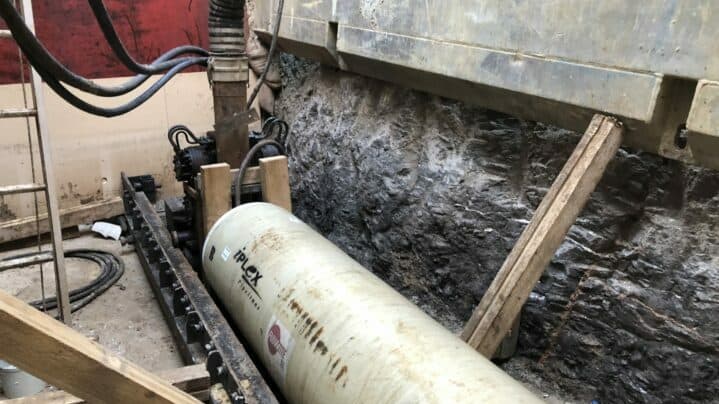A sudden change in ground conditions during a trenchless pipeline installation may require a rethink of how the project should proceed for the greatest chance of success. However, this can cause things to get complicated and costly when all parties involved have different ideas on how to proceed, and solicitors get involved. When presented with the possibility of such a situation occurring on a project site, Edge Underground collaborated with the other parties to come up with an alternative solution, saving the client time and money.
In October 2019, Edge Underground was engaged by Diona for trenchless works on Yarra Valley Water’s Donnybrook Link Sewer Stage 2 project. The project comprised 2.4km of DN700 GPR pipe – 1km to be completed by trenchless and 1.4km by open cut – with depths varying from 8-14m. The trenchless section included depths from 10-14m over ten bore lengths.
Dealing with the most difficult ground conditions
According to Stuart Harrison, Managing Director at Edge Underground, Donnybrook is notorious for its difficult ground conditions.
“We used normal microtunnelling heads for the shallower sections of the project, but we found the rock in some areas to be very high strength (250MPa+), with several anomalies including large voids/fractures which were inconsistent with the geotechnical information,” Mr Harrison said.
“On top of that, the ground was made up of intersected lava flows from different volcanoes that were located in different directions. We also found areas of rock that were 0.5 on the hardness scale that were formed from two layers of lava meeting with a gaseous layer to form a lava tunnel.
“This meant we were trying to drill through areas of ground where there was no support for the drill, which puts the drill head at risk of snapping.
“There were also high water flows where water quenching had occurred, adding the extra challenge of the drill head changing structure where hot steel met the water.”
Mr Harrison said that in this situation, usually the only option would be to upsize from DN700 to DN1200 and install concrete casing pipe – a greater cost to the client. However, Edge Underground proposed using a new innovative and pioneering advancement based on its new pneumatic rock hammer that its team had just developed, which uses air-driven hammers (similar to vertical DTH heads) on its AXIS laser guided system. This system was previously untried and is a new technology to the microtunnelling market.
A different approach
“We presented what we determined to be the best solution to the conditions present that would be successful while also keeping costs down,” Mr Harrison said.
“But with these types of situations, each party involved can have very different ideas about how to deal with the difficult ground conditions.
“Typically when this occurs, each party brings in their own solicitors to resolve the situation through legal processes. The problem with this is that it can result in a deadlock, costing time and money for the project and parties alike.
“However, everyone on this project was open-minded and willing to come together to discuss a common goal honestly and transparently, so instead of taking the normal route to resolution, we all agreed to bring in a third party independent expert to make a determination.”
Adam Shayler, Manger – Trencless at Bamser, and his team were brought in to help with the determination. Bamser has a background in different drilling methods and Ben Crosby is widely considered an industry leader, with microtunnelling one of his key areas of expertise. This expertise provided the knowledge needed to independently assess the project and come to a conclusion based on all the information available.
Through this collaboration, it was concluded the project was a perfect opportunity to test the new air hammer concept. This was a big risk for all involved, and could not have been done without the foresight of Yarra Valley Water to forge ahead with the technology.
According to Mr Harrison, when using the new air hammer, a pilot line guides the head to maintain accuracy.
“It can be operated via the next generation AXIS drill rods with a power enhancing driver. The system uses high pressure air hammers in sequence – exhausting cuttings through a custom removal system – and is ideal for very high strength rock,” Mr Harrison said.
“The new system also has environmental and workplace health and safety benefits, enabling small to medium-size pipe diameters to be installed in hard rock faster, with a significant reduction in spoil removal and truck movements compared to open cut methods.”
Furthermore, when used in conjunction with the ‘keyhole’ pipeline installation method – pioneered by and synonymous with Edge Underground – it further reduces excavation requirements for smaller diameters, which in itself greatly improves health and safety outcomes on-site.
The result was a great success, with the technology surpassing all client expectations; microtunnelling on average four times faster than a conventional system, avoiding the need to upsize to a far larger diameter, and saving time and money.

